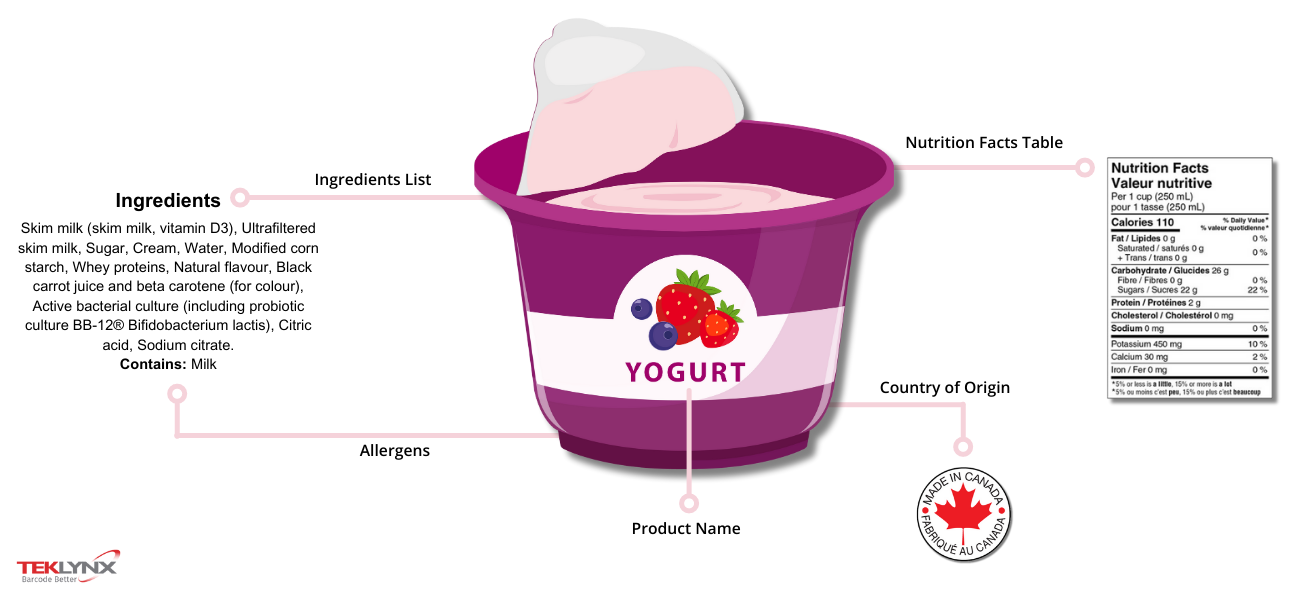בחרו את האזור והשפה שלכם כדי לחוות את אתר האינטרנט באופן מיטבי

Consumers are becoming more concerned about the quality and safety of the food they consume. To address these concerns, governments have established strict regulations for food labeling to prevent product recalls and illnesses. In Canada, robust food labeling requirements are in place for all manufacturers to ensure their labels on food products protect their consumers.
This blog will discuss Canadian food labeling requirements and how to comply by using barcode labeling software.
If you need help meeting regulatory compliance, or don’t know where to start, get in touch with a TEKLYNX labeling expert to help determine the best software solution for your business.
The Canadian Food Inspection Agency, also known as CFIA, enforces Canada's labeling laws regarding the declaration of allergens, gluten, and sulphites on packaged products for domestic and imported food items. CFIA works with companies in the case of a product recall to make sure the public is informed and the product was successfully removed from the shelves.
The Government of Canada states, “On average, the CFIA conducts approximately 2,837 food safety investigations each year. The goal of food safety investigations is to determine whether a food safety hazard exists, assess the nature and extent of the issue, and take appropriate actions to eliminate or minimize potential risks to consumers.” Agencies like CFIA help enhance the health and well-being of Canadian consumers, their environment, and their economy in the case of a product recall.
Now that we learned about CFIA, it's important to know what's required on Canadian food labels for consumer safety, and so consumers can identify and differentiate products. Requirements such as the nutrition facts table, ingredient list, and allergens are just a few of the critical items that must be listed on food labels.
What must be included on a Canadian food label?
Below is a label sample example with a few of the labeling requirements for food products in Canada. You can find more of the core food labeling requirements and claims and statements on the Government of Canada’s website.

Canadian food labeling compliance and regulations are overseen by the Canadian Food Inspection Agency (CFIA) and Health Canada. These regulatory compliances ensure that food labeling meets specific standards to protect consumers and provide accurate information. Below are the three legislations for Canadian food labeling regulations.
The FDR aims to protect the health and safety of Canadian residents with the sale of food and drug products. This regulation sets out specific requirements for labeling, packaging, manufacturing, importing, and distribution of food and drugs. Regulations like FDR help guarantee all food and drug products are safe as they make their way through the supply chain before they end up in the hands of the consumer.
SFCR requires food businesses that import or prepare food to be exported or sent across provinces to have a license and preventive controls to address the potential risks of food safety. SFCR consolidates many other regulations to streamline food safety requirements.
SFCA, the legislation for SFCR, is a law covering imported, exported, or inter-provincially traded food products. Both SFCA and SFCR help provide food safety for all consumers and food businesses in Canada. Canadian companies should familiarize themselves with these regulations so they can prevent foodborne illnesses and quickly remove unsafe food in the case of a recall.

FOP labeling is for most prepackaged products containing nutrients of public health concern (saturated fat, sugars, or sodium) at or above specified thresholds. The FOP nutrition symbol will help Canadians identify foods high in these nutrients. Avoiding excess consumption of these nutrients can help reduce associated health risks. Canadian manufacturers, retailers, and importers of foods for sale in Canada and foreign companies that export food to Canada must comply with the requirements for all components of these amendments by January 1, 2026.
To comply with all Canadian food label requirements, make sure your software provider has specific features to help meet these regulations. If companies do not comply with industry standards, they may face fines, product recalls, food-borne illnesses, bad press, legal action, and more, so it's critical to stay on top of all food safety standards. CODESOFT barcode label design software has many features that help meet Canadian food labeling requirements including:
CODESOFT can integrate with LABEL ARCHIVE label security and traceability software. LABEL ARCHIVE helps you reach compliance in the food industry with its features like permissions control, an electronic label approval process, and a full audit history of changes to every barcode label. These two solutions will help you establish security, prevent errors, and improve your labeling process.
Flexibility and scalability are important when it comes time to choose a solution. When looking for a new barcode labeling solution, choose a software provider that will grow with your business, adapt quickly to changing regulations, and have great customer support. By choosing a labeling partner that grows with you, everything becomes seamless.
The TEKLYNX team was very helpful in implementing the system and helping us through changes over the years.” - Doug B, Associate Director of Food Safety and Quality Assurance
By adhering to the ever-changing barcode labeling requirements, Canadian food manufacturers and suppliers can have greater supply chain efficiency, improve inventory management, and reduce errors in the event of a product recall. Having a barcode labeling software provider that helps you meet these goals for traceability and consumer safety benefits your consumers and your business.
TEKLYNX understands the unique labeling requirements for the food & beverage industry, which is why we provide software solutions to help simplify the entire labeling process, starting with label design. Whether you have a simple or complex labeling process, you can meet virtually any food & beverage labeling requirement with TEKLYNX software. Get in touch with a TEKLYNX labeling expert today to help you comply and meet industry standards.
DOWNLOAD A FREE TRIAL OF CODESOFT
Travis Wayne is the Product Manager at TEKLYNX. Travis applies his 20+ years of IT and health sciences experience to empower businesses to streamline operations and barcode better by applying software and technology. He works to continually improve TEKLYNX strategic planning, product and project management principles, and cross-functional communications. When not working, he enjoys many outdoor activities with his wife and two children.
The nutrition label is a critical piece of information for consumers when making purchasing decisions, but for food manufacturing companies, the label is much more than calories and an ingredient list. Although changes to food labeling requirements are infrequent, when changes are made, they can be substantial. Read the blog to learn how to comply.
READ MORE
When it comes to the food and beverage industry, it is incredibly important to have the best label software in place to ensure efficiency, stability, and peace of mind throughout the supply chain.
READ MORE
You’ve created a great product and made it to store shelves! Your hard work is starting to pay off, and now it’s time to make sure you’re setting your product up for the commercial success it deserves. Designing an attractive and professional product label is the best way to make sure your product stands out, and images are a great way to do just that.
READ MORE
What do you think? Leave us a comment.
Comments will be reviewed and are subject to TEKLYNX’ comment policy. Your email address will not be published publicly.